
Ornithocheirus is a pterosaur genus known from fragmentary fossil remains uncovered from sediments in the UK and possibly Morocco.

Tropeognathus is a genus of large pterosaurs from the late Early Cretaceous of South America. This genus is considered to be a member of the family Anhangueridae, however, several studies have also recovered it within another family called Ornithocheiridae. Both of these families are diverse groups of pterosaurs known for their keel-tipped snouts and large size. Tropeognathus is regarded as the largest pterosaur found in the Southern Hemisphere, only rivaled by the huge azhdarchids. The type and only species is Tropeognathus mesembrinus. Fossil remains of Tropeognathus have been recovered from the Romualdo Formation, which is a Lagerstätte located in the Santana Group of the Araripe Basin in northeastern Brazil.

Amblydectes is a genus of pterosaur known from jaw fragments. It apparently had a jaw flattened towards the tip and triangular in cross-section. It has at times been synonymized with Coloborhynchus, Criorhynchus, Lonchodectes, or Ornithocheirus. A 2013 study found A. crassidens and A. eurygnathus to be nomina dubia, with A. platystomus possibly belonging to a separate, yet unnamed genus. A 2021 study found A. crassidens to be a valid genus within Anhangueridae, while A. platystomus was placed in the new genus Draigwenia. A. eurygnathus was found to be possibly a junior synonym of A. crassidens.
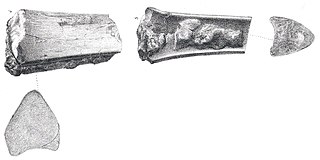
Ornithostoma is a genus of pterodactyloid pterosaur that lived during the Early Cretaceous period of Europe, around 110 million years ago. Ornithostoma was once thought to have been a senior synonym of the pteranodontid Pteranodon due to its toothless anatomy and prior naming.
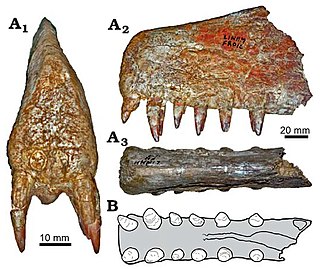
Siroccopteryx is an extinct genus of anhanguerid pterodactyloid pterosaur, known from middle Cretaceous sediments in modern-day Morocco. Some researchers, such as David M. Unwin, consider the genus a junior synonym of Coloborhynchus.
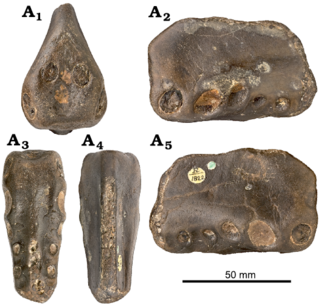
Coloborhynchus is a genus of pterodactyloid pterosaur belonging to the family Anhangueridae, though it has also been recovered as a member of the Ornithocheiridae in some studies. Coloborhynchus is known from the Lower Cretaceous of England, and depending on which species are included, possibly the Albian and Cenomanian ages as well. Coloborhynchus was once thought to be the largest known toothed pterosaur, however, a specimen of the closely related Tropeognathus is now thought to have had a larger wingspan.

Lonchodectes was a genus of lonchodectid pterosaur from several formations dating to the Turonian of England, mostly in the area around Kent. The species belonging to it had been assigned to Ornithocheirus until David Unwin's work of the 1990s and 2000s. Several potential species are known; most are based on scrappy remains, and have gone through several other generic assignments. The genus is part of the complex taxonomy issues surrounding Early Cretaceous pterosaurs from Brazil and England, such as Amblydectes, Anhanguera, Coloborhynchus, and Ornithocheirus.

Lonchodectidae or Lonchodraconidae is a group of pterosaurs within the clade Pterodactyloidea. It has variously been considered to be within Ctenochasmatoidea, Azhdarchoidea and Pteranodontia. They are notable for their high, conical tooth sockets and raised alveolar margins.
"Palaeornis" cliftii is a pterosaur species known from parts of a single humerus found in the early Cretaceous (Valanginian) of the upper Tunbridge Wells Sand Formation, England.

Ornithocheiridae is a group of pterosaurs within the suborder Pterodactyloidea. These pterosaurs were among the last to possess teeth. Members that belong to this group lived from the Early to Late Cretaceous periods, around 140 to 90 million years ago.
The Cambridge Greensand is a geological unit in England whose strata are earliest Cenomanian in age. It lies above the erosive contact between the Gault Formation and the Chalk Group in the vicinity of Cambridgeshire, and technically forms the lowest member bed of the West Melbury Marly Chalk Formation. It is a remanié deposit, containing reworked fossils of late Albian age, including those of dinosaurs and pterosaurs.

Uktenadactylus is a genus of anhanguerid pterodactyloid pterosaurs from the Lower Cretaceous Paw Paw Formation of Texas, United States and the Wessex Formation on the Isle of Wight, England. Fossil remains of Uktenadactylus dated back to the Early Cretaceous period, from about 125 to 100 million years ago.

Cimoliopterus is a genus of pterosaur that lived during the Late Cretaceous in what is now England and the United States. The first known specimen, consisting of the front part of a snout including part of a crest, was discovered in the Grey Chalk Subgroup of Kent, England, and described as the new species Pterodactylus cuvieri in 1851. The specific name cuvieri honours the palaeontologist George Cuvier, whereas the genus Pterodactylus was then used for many pterosaur species that are not thought to be closely related today. It was one of the first pterosaurs to be depicted as models in Crystal Palace Park in the 1850s. The species was subsequently assigned to various other genera, including Ornithocheirus and Anhanguera. In 2013, the species was moved to a new genus, as Cimoliopterus cuvieri; the generic name Cimoliopterus is derived from the Greek words for "chalk" and "wing". Other specimens and species have also been assigned to or synonymised with the species with various levels of certainty. In 2015, a snout discovered in the Britton Formation of Texas, US, was named as a new species in the genus, C. dunni; the specific name honours its collector, Brent Dunn.
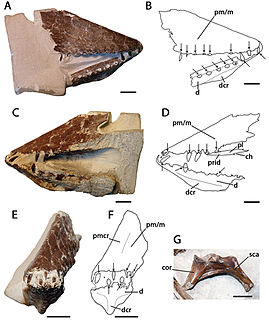
Lonchodraco is a genus of lonchodraconid pterodactyloid pterosaur from the Late Cretaceous of southern England. The genus includes species that were previously assigned to other genera.
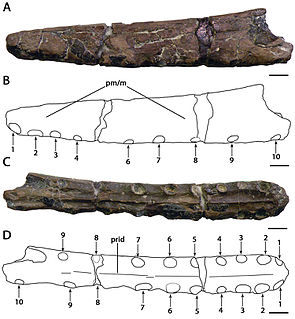
Camposipterus is a genus of pterodactyloid pterosaur from the Early Cretaceous of England. Fossil remains of Camposipterus dated back to the Early Cretaceous, about 112 million years ago.

Ikrandraco is a genus of lonchodraconid pterodactyloid pterosaur known from Lower Cretaceous rocks in northeastern China and the Cambridge Greensand of the UK. It is notable for its unusual skull, which features a crest on the lower jaw.

Ornithocheiromorpha is a group of pterosaurs within the suborder Pterodactyloidea. Fossil remains of this group date back from the Early to Late Cretaceous periods, around 140 to 92.5 million years ago. Ornithocheiromorphs were discovered worldwide except Antarctica, though most genera were recovered in Europe, Asia and South America. They were the most diverse and successful pterosaurs during the Early Cretaceous, but throughout the Late Cretaceous they were replaced by better adapted and more advanced pterosaur species such the pteranodontids and azhdarchoids. The Ornithocheiromorpha was defined in 2014 by Andres and colleagues, and they made Ornithocheiromorpha the most inclusive clade containing Ornithocheirus, but not Pteranodon.

Serradraco is a genus of Early Cretaceous pterodactyloid pterosaur from the Valanginian aged Tunbridge Wells Sand Formation in England. Named by Rigal et al. in 2017 with the description of a second specimen, it contains a single species, S. sagittirostris, which was formerly considered a species of Lonchodectes, L. sagittirostris. In 2020, Averianov suggested it did not belong in Lonchodectidae.

Nicorhynchus is a genus of anhanguerid pterosaur from the Cretaceous period. It contains two species, the type species, N. capito, from the Cambridge Greensand of England, and N. fluviferox from the Kem Kem Group of Morocco. These species were previously assigned to Coloborhynchus.

Aerodraco is a genus of anhanguerid pterosaur from the Albian–Cenomanian-age Cambridge Greensand of England. It contains only one species, Aerodraco sedgwickii. It was originally assigned to the genus Pterodactylus.




























